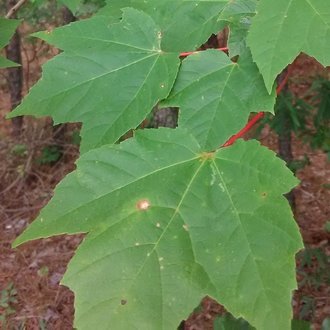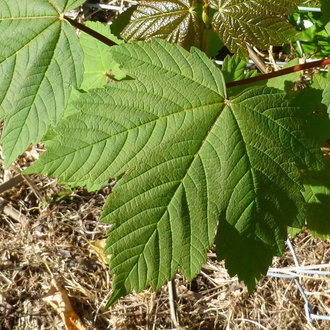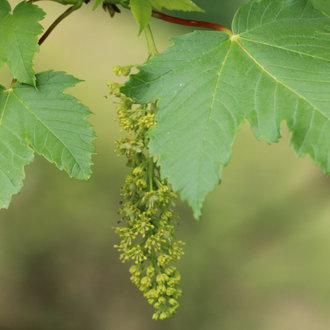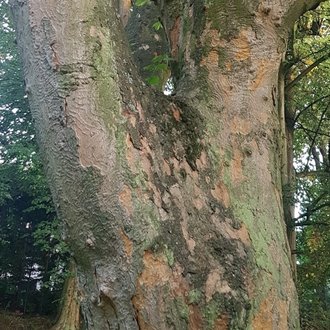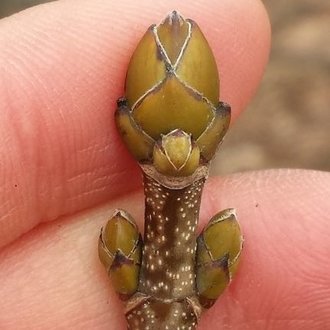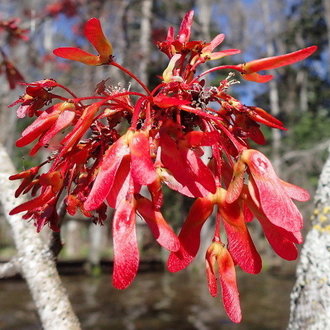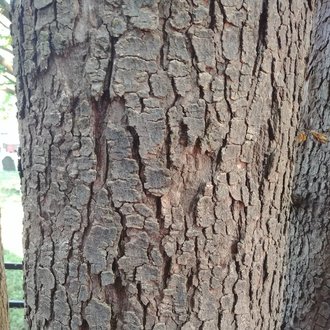Red Maple vs Sycamore Maple
These two species are sometimes confused, especially when people do not know to check against Sycamore maple. Both have serrated leaf margins and frequently have reddish-tinged petioles, samaras, and other features. The flower structure and timing is radically different, but the species can also be distinguished by leaves and buds with relative ease if you know what to look for. In North America, red maple is widespread and common, whereas sycamore maple is uncommon in the wild, and usually most common in and near urban areas.
Red Maple (Acer rubrum) | Sycamore Maple (Acer pseudoplatanus) |
The most abundant tree species in North America, and a habitat generalist, native to a wide range across the eastern part of the continent. | A large maple with invasive potential. In the UK, referred to only as "sycamore"; in the U.S. this name is reserved for the American sycamore and other trees of the Platanus genus. |
Leaves have fewer side veins, which are usually lighter in color than the rest of the leaf. Leaves look flatter and smoother in texture. Leaves often shinier. Photo © coatlicue (iNaturalist), Public Domain. | Leaves have numerous side veins which are prominently depressed and often look darker than the leaf surface, giving the leaf a ridged appearance. Photo © Murray NZ, CC BY 4.0. |
Blooms early, before trees leaf out. Blooms in bright red flowers that are attached directly to twigs. Photo © Mark, CC BY 4.0. | Blooms late, after leaves are fully formed. Blooms in a long dangling cluster of small greenish-yellow flowers. Photo © Thraen, CC BY-SA 4.0. |
Bark of mature trees tends to form long, vertical cracks. Color is consistently gray. Photo © Katja Schulz, CC BY 4.0. | Bark of mature trees often flakes off in blocks, leading to a mottled appearance, with a pinkish color underneath. Photo © Tomas P., Public Domain. |
Buds reddish. Side buds often as large as terminal buds. Photo © Ben Armstrong, CC BY 4.0. | Buds yellowish-green. Side buds markedly smaller than terminal buds. Photo © Zihao Wang, CC BY 4.0. |
Wings of samaras are bright red throughout. In clusters where each samara is roughly equidistant from the point of attachment at the twig. Photo © mfeaver, CC BY 4.0. | Wings of samaras are often pinkish to slightly reddish, but less red throughout; grouped in long, dangling clusters, with some samaras closer to the twig and others farther. Photo © jhubley, Public Domain. |
Bark of old trees forms long, vertical strips, with few horizontal cracks. Strips tend to remain attached in the middle but peel away at the ends. Photo © Laura Costello, CC BY 4.0. | Bark of old trees is irregularly cracked in blocks or plates with numerous horizontal cracks. Some small chunks fall off, exposing inner layers of bark. Photo © Laura Costello, CC BY 4.0. |
References & External Resources
These short lists show only links helpful for ID. For a complete list of references and resources also covering other aspects of ecology, visit the links section of the full article on each plant, which is the first entry here.



